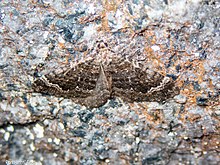Asaphodes chionogramma
| Asaphodes chionogramma | |
|---|---|

| |
| Male | |

| |
| Female | |
| Scientific classification | |
| Domain: | Eukaryota |
| Kingdom: | Animalia |
| Phylum: | Arthropoda |
| Class: | Insecta |
| Order: | Lepidoptera |
| Family: | Geometridae |
| Genus: | Asaphodes |
| Species: | A. chionogramma
|
| Binomial name | |
| Asaphodes chionogramma | |
| Synonyms[2] | |
| |
Asaphodes chionogramma is a moth in the family Geometridae. It is endemic to New Zealand and found in both the North and South Islands. This species inhabits the lower slopes of mountains in valleys with native forest at altitudes of between 2000 and 3000 ft. The adults of this species are on the wing in December and January.
Taxonomy
[edit]
This species was first described by Edward Meyrick in 1883 as Larentia chionogramma.[3] Meyrick gave a fuller description of the species later in 1884.[4] George Hudson discussed and illustrated the species in his 1898 volume New Zealand Moths and Butterflies and referred to it as Xanthorhoe chionogramma.[5] He also discussed and illustrated this species using that same name in his 1928 publication.[6] In 1971 J. S. Dugdale placed this species in the genus Asaphodes.[7] This placement was reaffirmed by Dugdale in 1988.[2] The male lectotype, collected at Mount Hutt, is held at the Natural History Museum, London.[2]
Description
[edit]

Hudson described the species as follows:
The expansion of the wings is about 1+1⁄8 inches. The fore-wings are rather dark greyish-brown ; there are numerous indistinct wavy paler and darker transverse lines near the base ; a rather broad transverse brown band towards the middle, shaded towards the base, and edged with an interrupted jagged white line towards the termen ; beyond this there are several broken darker and paler lines. The hind-wings are very pale greyish-ochreous, clouded with grey near the base, and with several rows of small cloudy grey spots near the termen. The female is paler than the male and the markings are less distinct.[5]
Distribution
[edit]Asaphodes chionogramma is endemic to New Zealand.[1] This species can be found in the North and South Islands.[6] Specimens of this species have been collected in the mid Canterbury.[2] Meyrick collected this species at Mount Hutt and Hudson stated the species had been collected in the North Island at Mount Taranaki and also occurred at Mount Arthur and Mount Hutt.[5]
Behaviour
[edit]The adults of this species is on the wing in December and January.[6]
Habitat
[edit]The habitat of this species is on the lower slopes of mountains in wooded valleys at altitudes of between 2000 and 3000 ft.[5]
References
[edit]- ^ a b "Asaphodes chionogramma (Meyrick, 1883)". New Zealand Organisms Register. Landcare Research New Zealand Ltd. Retrieved 15 December 2017.
- ^ a b c d John Stewart Dugdale (23 September 1988). "Lepidoptera - annotated catalogue, and keys to family-group taxa". Fauna of New Zealand. 14. Department of Scientific and Industrial Research: 172. doi:10.7931/J2/FNZ.14. ISSN 0111-5383. Wikidata Q45083134.
- ^ Edward Meyrick (September 1883). "Monograph of New Zealand Geometrina". New Zealand Journal of Science. 1: 528. Wikidata Q110691894.
- ^ Edward Meyrick (May 1884). "A Monograph of the New Zealand Geometrina". Transactions and Proceedings of the New Zealand Institute. 16: 82. ISSN 1176-6158. Wikidata Q109615359.
- ^ a b c d Hudson, G. V. (1898). New Zealand Moths and Butterflies (Macro-lepidoptera). London: West, Newman & co. p. 65. doi:10.5962/bhl.title.7912.
- ^ a b c George Vernon Hudson (1928), The butterflies and moths of New Zealand, Illustrator: George Hudson, Wellington: Ferguson and Osborn Limited, p. 114, LCCN 88133764, OCLC 25449322, Wikidata Q58593286
- ^ Dugdale, J. S. (10 November 1971). "Entomology of the Aucklands and other islands south of New Zealand: Lepidoptera, excluding non-crambine Pyralidae". Pacific Insects Monographs. 27: 55–172. ISSN 0078-7515. Wikidata Q64006453.
